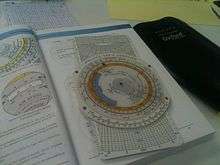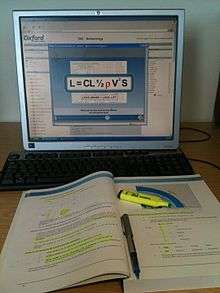Oxford Aviation Academy
 | |
Former names | Boeing |
|---|---|
| Motto |
"Skills For Flight" "Succeed Through Our Experience" |
| Type | Private |
| Established | 1961 |
| Endowment | £155.1 million (2012) |
| Chancellor | CAPT.Steve Rees |
| Vice-Chancellor | CAPT.Dave Pratt*MCC CFI: CAPT.Laurie Ramage*CFI: CAPT.Paul Taylor |
| Students | +450 |
| Location | Oxford, England, GB |
| Campus |
Oxford (Main campus) Phoenix (Foundation Flight Training) Melbourne (Melbourne Academy partners with Swinburne University of Technology) Gondia (Flight Academy) |
| Colours | Oxford Blue |
| Nickname | CAE OAA |
| Affiliations |
OAT Media Parc Aviation CAE Inc. |
| Mascot |
CAPT.Pete Pitcher CAPT.Nick Mylne CAPT.Tom Armstrong |
| Website | http://caeoaa.com |
CAE Oxford Aviation Academy (OAA), part of CAE Inc., is the largest ab initio flight training network in the world and it provides integrated aviation training and resourcing services. Professional airline pilots have been trained at Oxford Aviation Academy flight school since 1961.
OAA operates 125 training aircraft, 64 simulators and 10 training centres delivering a portfolio of aviation training courses. OAA's 3 ab initio airline pilot training[1] schools have trained more than 26,000 professional pilots over the past 50 years. OAA's 7 type training centres offer approved airline pilot, cabin crew[2] and maintenance engineer[3] training on a wide range of aircraft types including Boeing, Airbus, Bombardier, BAE Systems and Embraer.
Oxford Aviation Academy includes the former Oxford Aviation Training—a commercial pilot training school based at London Oxford Airport in the United Kingdom—and Phoenix Goodyear Airport in the United States; the former SAS Flight Academy, the former GECAT and the former BAE Systems Woodford, UK Training Centre, all of which are majority owned by STAR Capital Partners of London with a minority stake of less than 20% retained by GE Commercial Aviation Services.
The Airline Pilot Programme First Officer course is a full-time, Integrated Joint Aviation Authorities/European Aviation Safety Agency (JAA/EASA) course leading to the award of a 'Frozen' (becoming unfrozen when the candidate has completed 1500 hours in a multi-pilot environment) Airline Transport Pilot Licence (ATPL).
History
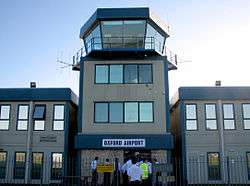
Oxford Flying Club was officially opened by the Mayor of Oxford in 1939. However, restrictions placed on civil aviation during World War II curtailed its activities and the airfield operated as RAF Kidlington for the duration of hostilities. The club reopened in 1947, renamed as the Oxford Aeroplane Club. During the 1950s it gradually increased its fleet and, by 1960, had become a flying school geared to the training of professional pilots.
In 1961, the flying school's parent company, Oxford Aviation, merged with the Pressed Steel Company to become British Executive Air Services Ltd. (BEAS). Dedicated ground school buildings and student residential accommodation were provided on site, and the first fully integrated Commercial Pilot's Licence (CPL) and instrument rating (IR) courses began in May 1962.
In 1963, the BEAS Flying Training Division was renamed Oxford Air Training School. Since then, over twenty thousand trained commercial pilots and aircraft engineers have graduated from the school. Including the first ever Commercial Space Shuttle Pilot's Licence which was awarded in 1989. The school changed its name to Oxford Aviation Training (OAT) in the 1990s.

On 19 June 2007, OAT's parent company BBA Aviation sold OAT to GCAT Flight Academy (formerly General Electric Commercial Aviation Training, part of General Electric and SAS Flight Academy, part of Scandinavian Airlines System) for $63 million (£32 million). The deal was backed by GCAT Flight Academy's majority shareholder, STAR Capital Partners an independent venture capital fund.
In early February 2008, GCAT Flight Academy changed its registered name to Oxford Aviation Academy Ltd. OAT's branding and logo adorning the training centre at Oxford and Goodyear Airports were replaced, with the new logo bearing the title 'Oxford Aviation Academy'. The insignia on the tailplanes of its Piper PA-28 Warrior and Piper PA-34 Seneca aircraft were also replaced with the new logo design. The new logo also appeared at the 8 locations formerly named GCAT Flight Academy, including those in Scandinavia and Hong Kong that GCAT purchased from SAS Flight Academy and the Woodford Training Center purchased from BAE Systems. These changes were a result of both GCAT Flight Academy and Oxford Aviation Training being re-branded as Oxford Aviation Academy.
In 2008, OAA acquired General Flying Services, based in Moorabbin, Victoria, Australia.[4]
APP First Officer
The flagship course of OAA is the full-time ab initio Integrated ATPL Training which is called Airline Pilot Programme First Officer (APP First Officer).
It is a JAA approved full-time course and is used to train pilots to the level of proficiency necessary to enable them to operate on a multi-crew aircraft in the position of a first officer, within a commercial airline. The course is designed for trainees who have little or no previous flying experience. The academy has strong connections with many of the world's leading airlines having built up a reputation for providing pilots to airlines through cadet schemes. Since 9/11, these "sponsored" programmes are very rare and most trainee's are now "self-sponsored," and can seek employment with any airline (using the JAA licence) upon graduation.
After a rigorous pre-selection process, successful candidates are offered a place on the Airline Preparation Programme, subject to Class 1 JAA medical requirements. The initial theory and 14 JAA/EASA ATPL exams as well as the Instrument Rating and Multi Crew Co-operation/Jet Orientation Course (MCC/JOC) are completed at OAAs Oxford Training Centre (located at Oxford Airport) while the Commercial Pilot's Licence (CPL) is gained at OAA's training facility at Falcon Field Airport in Mesa, Arizona.
Course structure
Assessment

To gain a place on the course it is necessary to complete a one-day assessment at OAA's Oxford training centre. The assessment is designed to test candidates':
- Aptitude
- Capacity
- Technical Knowledge
- Personality
- Team Skills
- Verbal Reasoning
- Communication Skills
- Commitment
If successful in completing the assessment to the necessary standard then applicants are able to join the APP First Officer course.
Ground School
The first six months of the course are all completed in Oxford and it is during this time that students work to complete the 14 JAA/EASA ATPL theoretical exams. Completion of these exams is a pre-requisite to travelling to Phoenix to complete the practical flying and taking of the CPL Skills Test.
The 14 ATPL exams are as follows:
- Principles of Flight
- Aircraft General Knowledge – Systems
- Aircraft General Knowledge – Instrumentation
- Human Performance
- Meteorology
- VFR Communications
- IFR Communications
- General Navigation
- Radio Navigation
- Flight Planning
- Aircraft Performance
- Mass & Balance
- Operational Procedures
- Air Law
At the end of the six months students will have completed 760 hours of ATPL Ground School. The average grade for students on an APP course is 80%. OAA's student pass rates are above average with more than 60% passing all 14 JAA papers on the first attempt.
Initial Flight Training
The next five months of the course are spent in Falcon Field Airport, United States which allows students to take advantage of the good weather and get used to busy general aviation airspace. The first 115 hours of flying are completed on the Piper Archer (PA28), a single piston-engine aircraft, including 3 hours on Extra 300L for upset recovery training. Ten hours of flying are then completed in the Piper Seminole (PA44), a multi-engine aircraft which is used for the commercial pilot license (CPL) skills test. When successful then students return from Phoenix, Arizona with a multi-engine CPL.
Advanced Flight Training
The Advanced Flight Training takes place back in Oxford and students will complete 40 hours' time in a Flight and Navigation Procedures Trainers (FNPT) II fixed-base simulator and 20 hours' flight time in the Piper Seneca V (PA34). This flying is designed to teach students to use aircraft instruments for navigation and culminates in the instrument rating skills test (IRT).
Multi Crew Coordination (MCC) and a Jet Orientation Course (JOC)
The final phase of training takes place over three weeks using a six-axis, full-motion Boeing 737-400 simulator at Oxford. Twenty hours are dedicated to the Multi Crew Coordination (MCC) which teaches students how to work effectively in a multi-crew environment. The final 20 hours focus on the JOC allows students to get used to operating a modern jet airliner.
In summary, the integrated course consists of 220 hours of flight training and 760 hours of ATPL theoretical knowledge training and lasts approximately 20 months—culminating in the issue of a EASA CPL with Instrument Rating and MCC credit. Following this course, a pilot is now qualified to gain employment in any airline within the EASA licensing region as a First Officer.
Fleet[5]

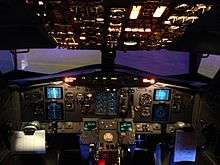



| Aircraft | Fleet | Location |
|---|---|---|
| Piper PA-28 Warrior | 31 | Phoenix Goodyear Airport, United States |
| Piper PA-28 Archer TX[6] | 22 | Phoenix Falcon Field, United States |
| Piper PA-34 Seneca | 22 | London Oxford Airport, GB & Phoenix Goodyear Airport, United States |
| Piper PA-44 Seminole[6] | 10 | Falcon Field Airport, United States & Moorabbin Airport, Australia |
| Cessna 172s & Cessna 182s | 30 | London Oxford Airport, GB, Tamworth Airport, Australia & Moorabbin Airport, Australia |
| 8KCAB Decathlon | 2 | Moorabbin Airport, Australia |
| Diamond DA42NG | 3 | Tamworth Airport, Australia |
| Socata TB-20 Trinidad | 2 | London Oxford Airport, GB |
| King Air BE90 | 2 | Moorabbin Airport, Australia |
| Zlín 242L | 1 | London Oxford Airport, GB |
| Total | 125 | |
Locations
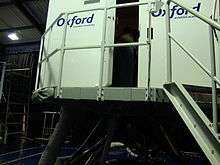
| Location | Type of training center |
|---|---|
| Oxford, Great Britain (Headquarters) | Airline Pilot Training - Ab Initio Europe & Simulators & Headquarters - Ground School |
| Brussels, Belgium | Airline Pilot Training - Ab Initio Europe & Simulators - Ground School |
| Phoenix, Arizona, United States [8] | Airline Pilot Training - Ab Initio Europe & Simulators - Flight Training |
| London Heathrow, Great Britain | Flight Crew Training (Type rating) & Simulators |
| London Gatwick, Great Britain | Flight Crew Training (Type rating) & Simulators |
| Manchester, Great Britain | Aircraft Maintenance Training & Cabin crew Training & Flight Crew Training (Type rating) & Simulators |
| Melbourne, Australia | Airline Pilot Training - Ab Initio Australia & Simulators |
| Tamworth, Australia | Airline Pilot Training - Ab Initio Australia & Simulators |
| Hong Kong | Flight Crew Training (Type rating) & Simulators |
| Stockholm, Sweden | Flight Crew Training (Type rating) & Simulators & Cabin crew Training |
| Seletar, Singapore | Flight Crew Training (Type rating) & Simulators & Cabin crew Training |
| Copenhagen, Denmark | Flight Crew Training (Type rating) & Simulators & Cabin crew Training |
| Oslo, Norway | Flight Crew Training (Type rating) & Simulators & Cabin crew Training |
| Beijing, China | Aviation Resourcing |
| Shanghai, China | Aviation Resourcing |
| Dublin, Ireland | Aviation Resourcing |
| Shannon Airport, Ireland | Aviation Resourcing |
| Tokyo, Japan | Aviation Resourcing |
| Dammam, Saudi Arabia [9] | Ground School |
Gallery
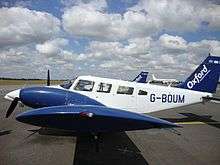 Piper PA-34 Seneca at London Oxford Airport
Piper PA-34 Seneca at London Oxford Airport Final approach of RWY03 of Phoenix Goodyear Airport
Final approach of RWY03 of Phoenix Goodyear Airport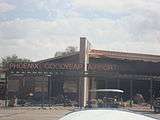 Phoenix Goodyear Airport one of the flying base of Oxford Aviation Academy
Phoenix Goodyear Airport one of the flying base of Oxford Aviation Academy
- A PA34 of Oxford Aviation Academy at Seneca's ramp at Phoenix Goodyear Airport
See also
References
- ↑ https://web.archive.org/web/20121211204147/http://oaa.com/pages/training_courses/ab_initio_europe/index. Archived from the original on 11 December 2012. Retrieved 11 January 2013. Missing or empty
|title=(help) - ↑ https://web.archive.org/web/20121230185654/http://www.oaa.com/pages/training_courses/cabin_crew_facilities. Archived from the original on 30 December 2012. Retrieved 11 January 2013. Missing or empty
|title=(help) - ↑ https://web.archive.org/web/20121017042233/http://oaa.com/pages/training_courses/aircraft_engineer. Archived from the original on 17 October 2012. Retrieved 11 January 2013. Missing or empty
|title=(help) - ↑ "General News". Moorabbinairport.com.au. 28 February 2012. Archived from the original on 3 December 2013. Retrieved 24 November 2013.
- ↑ "Archived copy". Archived from the original on 3 January 2013. Retrieved 11 January 2013.
- 1 2
- ↑ https://web.archive.org/web/20121214215053/http://www.oaa.com/pages/about_us/locations/oxford. Archived from the original on 14 December 2012. Retrieved 11 January 2013. Missing or empty
|title=(help) - ↑ https://web.archive.org/web/20121028234108/http://oaa.com/pages/about_us/locations/arizona. Archived from the original on 28 October 2012. Retrieved 25 January 2013. Missing or empty
|title=(help) - ↑ "CAE". Retrieved 2018-03-30.
External links
| Wikimedia Commons has media related to Oxford Aviation Academy. |
